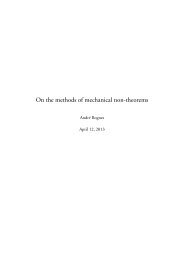The passive voice in written and spoken Scandinavian
The passive voice in written and spoken Scandinavian
The passive voice in written and spoken Scandinavian
Create successful ePaper yourself
Turn your PDF publications into a flip-book with our unique Google optimized e-Paper software.
<strong>passive</strong> than <strong>in</strong> the active <strong>voice</strong>. Biber et al. (1999: 479) give the follow<strong>in</strong>g examples:<br />
be + born, reputed, based (on), deemed, positioned, subjected (to). In addition, there<br />
are a few <strong>passive</strong> constructions that are found more commonly <strong>in</strong> conversations than<br />
<strong>in</strong> writ<strong>in</strong>g. Biber et al. (1999: 480) list the follow<strong>in</strong>g examples: can’t be bothered, be<br />
done, was meant, be allowed, be f<strong>in</strong>ished. As they po<strong>in</strong>t out, many of these<br />
expressions could, however, be analysed as the copula be followed by a predicative<br />
adjective (ibid: 480).<br />
Based on the discussion above, we should expect to f<strong>in</strong>d strik<strong>in</strong>g similarities<br />
between the Danish <strong>and</strong> Norwegian <strong>passive</strong> <strong>voice</strong>s, whereas the Swedish <strong>passive</strong><br />
<strong>voice</strong> probably will behave differently. This expectation is first <strong>and</strong> foremost based on<br />
two aspects. <strong>The</strong> first relates to the <strong>in</strong>complete tense paradigm of the Danish <strong>and</strong><br />
Norwegian morphological <strong>passive</strong>, which we would expect to translate <strong>in</strong>to a lower<br />
frequency of s-<strong>passive</strong>s <strong>in</strong> these two languages. Secondly, it is reasonable to assume<br />
that the numerous semantic <strong>and</strong> syntactic restrictions related to the Swedish<br />
periphrastic <strong>passive</strong> (with the auxiliary bli) will limit the usage of this construction.<br />
<strong>The</strong>re is no obvious reason to assume that the restrictions discussed above<br />
only apply to <strong>written</strong> language, <strong>and</strong> we would therefore expect to f<strong>in</strong>d similar<br />
tendencies <strong>in</strong> the <strong>spoken</strong> material. <strong>The</strong>re is, however, an additional factor mentioned<br />
above that can <strong>in</strong>fluence the results, namely the preferential use of the morphological<br />
<strong>passive</strong> <strong>in</strong> <strong>written</strong> language. Furthermore, as po<strong>in</strong>ted out by Biber et al., the <strong>passive</strong><br />
<strong>voice</strong> <strong>in</strong> English is generally more frequent <strong>in</strong> <strong>written</strong> than <strong>in</strong> <strong>spoken</strong> language, a<br />
tendency we would expect to f<strong>in</strong>d <strong>in</strong> Sc<strong>and</strong><strong>in</strong>avian languages too.<br />
2.5 Non-<strong>passive</strong> verbs end<strong>in</strong>g <strong>in</strong> –s<br />
Before go<strong>in</strong>g on to the analysis of the corpus f<strong>in</strong>d<strong>in</strong>gs, a short comment is needed <strong>in</strong><br />
order to delimitate <strong>passive</strong> from other <strong>passive</strong>-like constructions. This is important<br />
<strong>in</strong> relation to the cod<strong>in</strong>g of the empirical material to be presented <strong>in</strong> the next section.<br />
Most researchers assume that the Sc<strong>and</strong><strong>in</strong>avian morphological <strong>passive</strong> has<br />
developed from the reflexive pronoun sik. Dur<strong>in</strong>g historical development the –s<br />
suffix has, however, atta<strong>in</strong>ed different mean<strong>in</strong>gs. In addition to its reflexive mean<strong>in</strong>g,<br />
it has furthermore atta<strong>in</strong>ed reciprocal, medial <strong>and</strong> <strong>passive</strong> mean<strong>in</strong>g (Wessén 1992:<br />
173–182). In present-day Sc<strong>and</strong><strong>in</strong>avian languages, the so-called s-verbs, i.e. verbs<br />
end<strong>in</strong>g <strong>in</strong> –s, still have all these functions, although not all of them are productive <strong>in</strong><br />
12

















